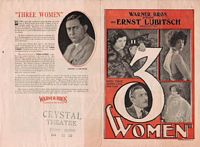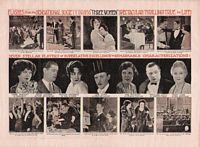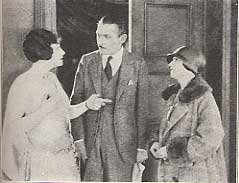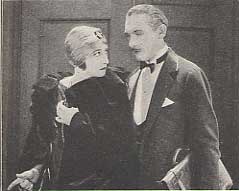

Three Women (1924) Warner Brothers Pictures. Director: Ernst Lubitsch. Scenario: Hans Kraly. Story: Ernst Lubitsch, Hans Kraly. Camera: Charles J. Van Enger. Art Director, Svend Gade. Assistant Directors, James Flood, Henry Blanke. Cast: May McAvoy, Pauline Frederick, Marie Prevost, Lew Cody, Willard Louis, Pierre Gendron, Mary Carr, Raymond McKee, Max Davidson. 8 reels.
A copy of this film is held by George Eastman House (35 mm). This was the biggest critical success of her career. It has been shown on TCM and will be out on video from Kino Lorber
 |
Front and back of a herald for the film (Thanks to Derek Boothroyd) |
 |
Ernst Lubitsch Production presented by the Warner Bros. Directed by Ernst Lubitsch, featuring May McAvoy, Pauline Frederick, Marie Prevost, and Lew Cody. shown at the Strand, N.Y. week Oct. 5, 1924. Running time, 82 min.
| Jeanne Wilson | May McAvoy |
| Mabel Wilson, her mother | Pauline Frederick |
| Harriet | Marie Prevost |
| George Lamont | Lew Cody |
| John W. Howard | Willard Louis |
| Fred Colman | Pierre Gendron |
| His Mother | Mary Carr |
| Fred's friend | Raymond McKee |
"Three Women" is an exposition of as pretty a piece of direction as has been seen on the screen in some time. For this Ernst Lubitsch is to be credited. With it all there is a story that will get to audiences, women especially, for it is a type of society drama that they all like in the picture houses. This in addition to a quartet of names that mean a lot at the box office, makes this a sure-fire production to pull money.
There is one thing that audiences won't want until they have seen the picture, for Pauline Frederick is not yet of the age where she is to be relegated to "mother roles." In this picture she plays a mother to an 18-year-old daughter. However, the manner in which the story is handled and the characterization that Miss Frederick gives makes her just as charming as in the days when she served tea in her dressing-room at the old Savoy theatre on West 34th street. Pauline Frederick playing mother to Mae [sic] McAvoy is something of a shock at first glance, but not so great after one has seen the picture.
The heavy is handled by Lew Cody, who appears as a penniless Don Juan and lays siege to the heart of the $3,000,000 widow, Pauline Frederick. She is strikingly bedecked in jewels and Cody, with his creditors hounding him, steps right into the picture, and before long manages to lay a touch for $100,000, which is pretty heavy lover stuff even with a $3,000,000 widow. He is not aware that she has a daughter until the night he makes the heavy touch. The young girl has returned from school unawares and stepped right into her mother's romance. When Cody hears that the daughter is to receive half of the family fortune on her marriage he lays plans to win her; in fact, he compromises her, which makes marriage a necessity. As soon as the ceremony is set he starts playing around on the outside and sets up a second establishment, which is where the third woman comes in. She is Marie Prevost; but her's is little better than a bit in the picture.
In the finish it is the wife's mother that comes into the breach to save her daughter's happiness, and when her former lover attacks her she shoots him down, finally being acquitted for the crime. This leaves the daughter free to revive a school-time romance and bring about a happy ending.
In flavor the story is decidedly European, although its scenes are laid principally in New York, with a few early shots in Berkeley, Calif.
Lubitsch does not resort to but one written title to convey the entire story of the young daughter's downfall in the entire sequence. That is direction. Everything is suggestion in facial expression, without a single scene that anyone, censor or otherwise, could find fault with.
Cody in his role is magnificent, but it is to Pauline Frederick that the honors for the best performance in the picture must be handed. She walked away with every scene she was on in, no matter who was playing opposite. May McAvoy displayed decided talent as the daughter, but she could not for a moment compete with the more experienced actress. Willard Louis, in a comedy role, handled himself competently, while Mary Carr also filled in aptly in several scenes. Raymond McKee and Pierre Grendon are also in the cast, completing a list of names that might well be designated as "all Star."
The sets and the lightings are as near perfect as have been seen in some time, and the story is carried along so smoothly that there is not a draggy spot in the picture.
This one will get money.
"Three Women"
Lubitsch Scores Again for Warner Brothers with Modern Domestic Drama of Absorbing Interest
Reviewed by Reviewed by C.S. Sewell.
Once again has Ernst Lubitsch demonstrated his versatility and remarkable ability as a director. In "The Marriage Circle" he showed he was as much in his element with clever and sophisticated domestic comedy with a continental flavor as with the heavily romantic and spectacular productions, which made him famous. Now in "Three Women," his newest picture for Warner Brothers, he has taken an intimate story with an American setting, that is straight domestic drama dealing with human frailties and handled it in the same masterful way.
Mr. Lubitsch goes the familiar triangle domestic drama one better, for this story involves the romantic affairs of one man and three women, and the fact that two of the characters are mother and daughter lends additional interest. In a sense, the plot embraces a progressive triangle situation, for the third woman is not introduced until man has lost interest in the first.
The unfolding of this story reveals excellent dramatic construction. starting out in a light vein, with many touches of clever comedy, there is no hint of the intense drama that is to follow. The interest, however, gradually mounts higher and higher and the dramatic values increase, culminating in a powerful climax in which the philandering husband is shot dead by his wife's mother, who was his former sweetheart. Even then there is no lessening in the denouement which brings about the satisfactory straightening out of the tangled affairs and the happy ending for the young wife with the man she really loves.
Mr. Lubitsch's direction is marked by the same subtle touches, the same unerring ability to portray human nature, its fine points and its frailties; the delightful touches of comedy , the power to register this points by short and constantly changing scenes and shots focused on exceedingly limited areas, all the while preserving excellent continuity.
Dealing with the affairs of a young fellow who held women lightly and three women to only one of whom he was married, there are some daring scenes and sensational inferences in the development, but they have been cleverly and discreetly handled. Obviously this is not a Sunday school story and it may mildly shock the unsophisticated, but it is a production that should register heavily with a large majority of spectators.
The cast is of the same calibre as the direction and dramatic force of the story. We doubt if a better selection could have been made than Lew Cody as the man and Pauline Frederick as the mother. Never have these two, in our opinion, given finer performances, and their work is truly excellent. The same is true of May McAvoy as the young wife, Marie Prevost as the third woman, and Willard Louis, Mary Carr and Pierre Gendron in minor roles. Their work is another evidence of Mr. Lubitsch's remarkable ability as a director.
Cast:| Jeanne Wilton | May McAvoy |
| Mrs. Wilton | Pauline Frederick |
| Harriet | Marie Prevost |
| Edmund Lamont | Lew Cody |
| Fred Armstrong | Pierre Gendron |
| Mrs. Armstrong | Mary Carr |
| Harvey Craig | Willard Louis |
Story and direction by Ernest [sic] Lubitsch.
Length, 8,200
Photographed by Charles Van Enger.
The Story:
Besieged by his creditors, Edmund Lamont welcomes the chance to follow up a meeting with a rich widow, Mrs. Wilton. His affair with her is progressing and he has even secured money from her to invest when Mrs. Wilton's grown daughter Jeanne arrives and Lamont transfers his affections, finally compromises the girl and marries her. Jeanne, though innocent minded, soon begins to doubt Lamont. A row in a cabaret resulting in his being brought home wounded reveals Lamont's intentions to another woman, Harriet, who taunts Jeanne with having stolen Lamont from her own mother. Mrs. Wilton, realizing the unhappy situation, begs Lamont to free Jeanne, but he refuses, threatening a scandal. Mrs. Wilton kills him, bares the whole situation on the stand and is acquitted, leaving Jeanne free to marry her real sweetheart, Fred Armstrong, a young doctor.
November 1924
[Photoplay also names Three Women one of the six best pictures of the month and Pauline Frederick's as one of the six best performances.
 |
THREE WOMEN--Warner Brothers
This story, produced by Ernst Lubitsch, is a sophisticated one; of the emotional struggle of a woman and her grown daughter over a man. One is a widow, world weary, afraid to grow old and a typical lover of love. The other is young, just out of school, viewing life through the rosy eyes of youth. The girl wins the man, himself a bored player with life, but into their life comes a third woman, a typical flirtatious charmer. The story suddenly dips into tragedy when the older woman, the mother, takes matters into her own hands and shoots the philandering husband of her daughter.
Not a savory tale, this, and yet told smoothly and easily by Lubitsch. There are times when the director has his minor characters, as the money-lenders, acting in too Continental fashion. Indeed, the whole viewpoint permeating the picture is European. This may mitigate against its success, but there is a superb performance of the older woman by Pauline Frederick, to lift it right up to the heights.
This performance by Miss Frederick is well worth seeing. It is limned with a fine understanding of life and colored with gripping fire and force. The remainder for the cast is more than adequate, with May McAvoy as the daughter, Lew Cody as the husband, and Marie Prevost as the third woman.
We offer "Three Women" to our readers with reservations. It is not a picture for the whole family. But, as a variation of the emotional triangle, it is an interesting and above-the-average effort, well directed and well played. And Miss Frederick's work in this film is worth going miles to see.
 |
This picture also appeared in the Sept. 1924 issue with the caption:
Hello Pauline! Glad to see you back on the screen. This is Miss Frederick and Lew Cody as they appear in "Three Women," her first venture in filmland for, lo, these many days. Looks as if Pauline is giving Lew orders.
A top class picture with the intelligence and sophistication that characterize Lubitsch's best films. Frederick is outstanding as the mother desperately clinging to her youth. May McAvoy is very good as the neglected daughter, giving a performance marked by simplicity and sincerity.. The "third woman" of the title, Marie Prevost, has little footage but makes her mark as Cody's rather vulgar and mercenary mistress, looking amusingly incongruous decked out like a femme fatale, complete with long cigarette holder, like a child playing dress-up. Cody plays yet another scummy cad, which he always does effectively. Max Davidson turns up in an unbilled part as a jeweler. This particular print seems to have come from a French-titled version, and two intertitles were not translated (though there is no trouble in understanding them).
Print viewed: Eastman House 35mm print.
More information on this film can be found in the following source:
Magill, Frank N., ed., Magills Survey of Cinema: Silent Films. Englewood Cliffs, N.J.: Salem Press, c1982 (entry on Three Women by Tanita C. Kelley).
Last revised, December 28, 2021